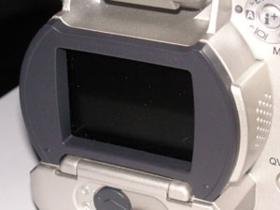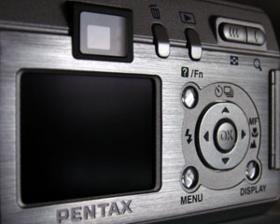Viewfinders
To the photographer, the viewfinder is the most visible part of a camera. Yet photographers barely want to notice it. What they are interested in is what they see through the viewfinder: their subject and sometimes a few unobtrusive indicators of the camera's status. Surprisingly, the viewfinder is one of the most controversial parts a modern camera. With the advent of digital cameras, the controversy has escalated.
To each their own
Practically all digital cameras sport an LCD (Liquid Crystal Display). For non-SLR digital cameras, it can be used to preview pictures taken and therefore serves the same purpose as a viewfinder. For several modern digital cameras, the LCD has become their only viewfinder. A growing number of digital cameras, particularly long-zoom and wide-angle cameras, use an EVF (Electronic Viewfinder) in addition to the camera's rear LCD. These miniature LCDs are the only eye level viewfinder alternatives for long zoom cameras. Just like their film counter-part, point and shoot digital cameras can have an optical-tunnel viewfinder. An optical tunnel viewfinder is a small tunnel going through the camera with a miniature lens which is fixed above or next to the camera's photographic lens. Finally, DSLR (Digital Single Lens Reflex) cameras use optical viewfinders which see through the lens using a pentaprism or porro finder just like their film SLR counterparts.

What you see is mostly what you get
The percentage of a picture that is seen through a viewfinder is called coverage. The closer the coverage is to 100% the better.
Just like a viewfinder, an LCD shows the subject being photographed. In fact, it shows what will make it into the final picture extremely well. LCDs get their information directly from the camera's sensor. As such, LCDs can easily have 100% coverage. With respect to coverage, EVFs behave exactly like LCDs, 100% coverage is easily obtainable.
Contrarily to LCDs, optical tunnel viewfinders show a different picture than the one that will be taken. This is due to the fact that an optical tunnel looks through a different lens than the one used to take the picture. The closer the subject is to the camera, the greater the difference between what is seen and what will be pictured. This is called parallax error. Even at a distance, the coverage of an optical tunnel varies between 60% and 85%, which is far from ideal.
DSLR camera viewfinders look through the photographic lens and therefore show part of what will be pictured with no parallax errors. Due to manufacturing constraints however, most DSLR viewfinders don't show the entire picture. Typical coverage of DSLR viewfinders is between 92%-95%.

Stay focused
An LCD is a small display made up of a limited number of pixels; much less than the number of pixels that will be captured in a digital picture. This implies that even though LCDs can be quite large compared to a viewfinder, the amount of details they can show is limited. Of course, some LCDs are better than others. At 86,000 pixels, an LCD is very coarse, at 235,000 pixels it is much better, but this is still very far from what a camera's CCD can capture. This is where an LCD starts to fail the photographer, it cannot show the precise details that will be captured and more importantly it cannot show focus precisely.
Just like LCDs, EVFs can't show very fine details. On most prosumer cameras however, EVFs have much higher resolution than LCDs. This makes the problem less pronounced. Fuji, Kodak, Konica-Minolta, Nikon and Olympus each have several cameras with 220,000 to 311,000 pixels EVFs. The EVF champion however is the Konica-Minolta A2 at 922,000 pixels. This is equivalent to having a 0.44" TV right in front of your eye!
Optical tunnels do show details. They show all the details which our eyes can see. The only problem is that they don't show the details through the photographic lens. This means that what you see through an optical tunnel is not affected by changes to a camera's lens (except for zoom, which is simulated and causes parallax errors). In other words, you can't see the effect of focusing at all. Some optical tunnels even show everything blurry!
For visualizing focus, SLR cameras are the champions. They allow our eye to see through the photographic lens and pick up every slight change in focus. It turns out most SLR cameras default to keeping the aperture wide open until after the shutter is fully pressed. A larger aperture actually has a shallower depth of field (DOF) and therefore exaggerates the blurring outside the plane of focus. To see accurately what will be in focus, one must use the DOF-Preview function present on most modern DSLR and even some prosumer digital cameras.
Please Support Neocamera
All information on Neocamera is provided free of charge yet running this website is a huge endeavor. Purchases made via affiliate links found throughout the site help keep it running and up-to-date. There is no additional cost to you, so please consider buying via these links to our affilates:
Thank you for your support!
Updates
2025.11.13

Best Gifts for Photographers in 2025 by Budget
The annual Neocamera Photography Gift Guide updated to 2025. Find great gifts for photographers with any price budget.
2025.07.07

Stellar Photo Recovery Review
Review of Stellar Photo Recovery V12. This Windows and MacOS software can recover photos and videos in a huge number of formats from memory cards, USB drives, SSDs and HHDs.
2025.05.14

Huion Kamvas 13 Gen 3 Review
In-Depth review of the Huion Kamvas 13 Gen 3 Pen Display Tablet for photographers and graphic artists.
2025.01.18

Fujifilm GFX 2025 Lens Roundup
Lens Review roundup of Fujifilm GFX Medium-Format lenses. Quality, performance and handling of the GF20-35mm F/4R WR, GF30mm F/3.5 Tilt-Shift and the GF55mm F/1.7.
2024.11.18

Best 2024 Photography Gifts for Every Budget
Great gifts for photographers and photo enthusiasts selected for every budget among the best products of 2024.
2024.08.07

Eye Protection Tips for Professional Photographers
The four main considerations for professional photographers regarding eyewear.
2024.07.14

Fujifilm X100VI Review
Flagship fixed-lens compact digital camera with a 40 MP sensor and Image-Stabilization, a first for the series. Retro design featuring dual control-dials, plus direct ISO, Shutter-Speed and EC dials. Its hybrid viewfinder can switch between EVF and OVF mode.
2024.05.09

Fujifilm GFX100 II Review
Flagship 102 Megapixels Medium-Format Mirrorless Digital Camera with 8-Stop 5-Axis IBIS, 8 FPS Drive, 8K Video and 400 MP Super-Resolution capture in a weatherproof and freezeproof body with dual control-dials and dual memory-card slots.
2024.04.03

Fujifilm X-T5 Review
Newest Fujifilm flagship boasting a 40 MP APS-C sensor, 5-axis IBIS with 7-stop efficiency, 15 FPS continuous drive, 6.2K Video capture, dual control-dials and dual SDXC UHS-II slots in a sturdy weatherproof and freezeproof body.
2023.11.20

Best Digital Cameras of 2023
Find out which are the Best Digital Cameras of 2023. All the new Mirrorless Digital Cameras from entry-level to high-end professional.
2023.07.10

Fujifilm X-H2 Review
40 Megapixels APS-C Hybrid Mirrorless Digital Camera with 7-stop IBIS. Fastest shutter ever and 8K video capture. Large builtin EVF with 0.8X magnification and 5.8 MP, plus an Eye-Start Sensor. Packed with features and large number of controls in a weatherproof and freezeproof body.
2023.05.07

Sony FE 20-70mm F/4G Review
Review of the unique Sony FE 20-70mm F/4G lens. The optical zoom of this lens spans ultra-wide-angle and medium focal-length coverage, making it one of the most versatile Full-Frame lenses on the market.
2025.11.13
2025.07.07
2025.05.14
2025.01.18
2024.11.18
2024.08.07
2024.07.14
2024.05.09
2024.04.03
2023.11.20
2023.07.10
2023.05.07
NEWS
2025.12.02

Sony Upgrades Alpha 7 to 5th Generation
Digital Camera ○ Lens
2025.11.29

Venus Optics Releases New Zero-D Tilt-Shift Macro Lens
Lens
2025.11.23

Best Digital Cameras of 2025
Digital Camera
2025.11.14

Photography Gift Guide 2025 Edition
2025.11.06

Canon Announces Third-Generation R6 Mirrorless
Digital Camera ○ Lens
2025.10.23

Fujifilm Launches X-T30 III Plus New Wide Zoom
Digital Camera ○ Lens
2025.10.21

Peak Design Unveils Field Plate and Form Straps
2025.10.16

Nikon Unveils Z-Mount DX Lens Duo
Lens
2025.10.16

Venus Optics Unveils Fast Telephoto Prime Lens
Lens
2025.10.01

Think Tank Photo FocusPoint RollTop Backpacks
Bag
2025.09.30

Sony Produces Super Macro GMaster Lens
Lens
2025.09.17

Venus Optics Created First Telephoto Ultra-Macro Lens
Lens






